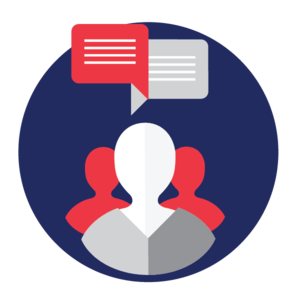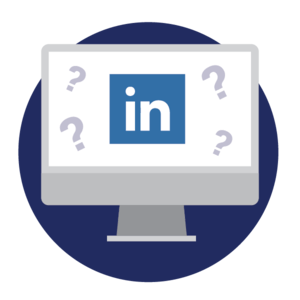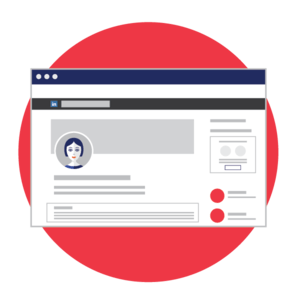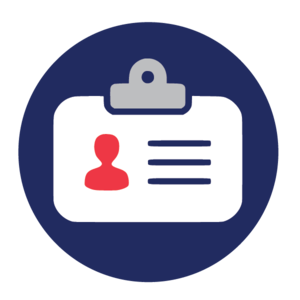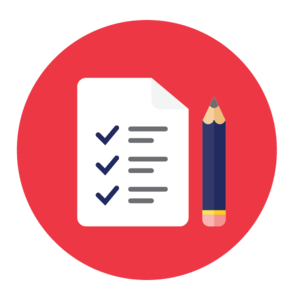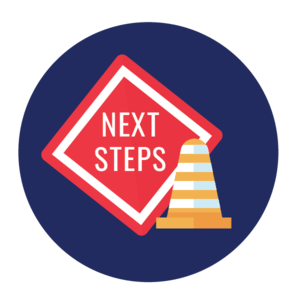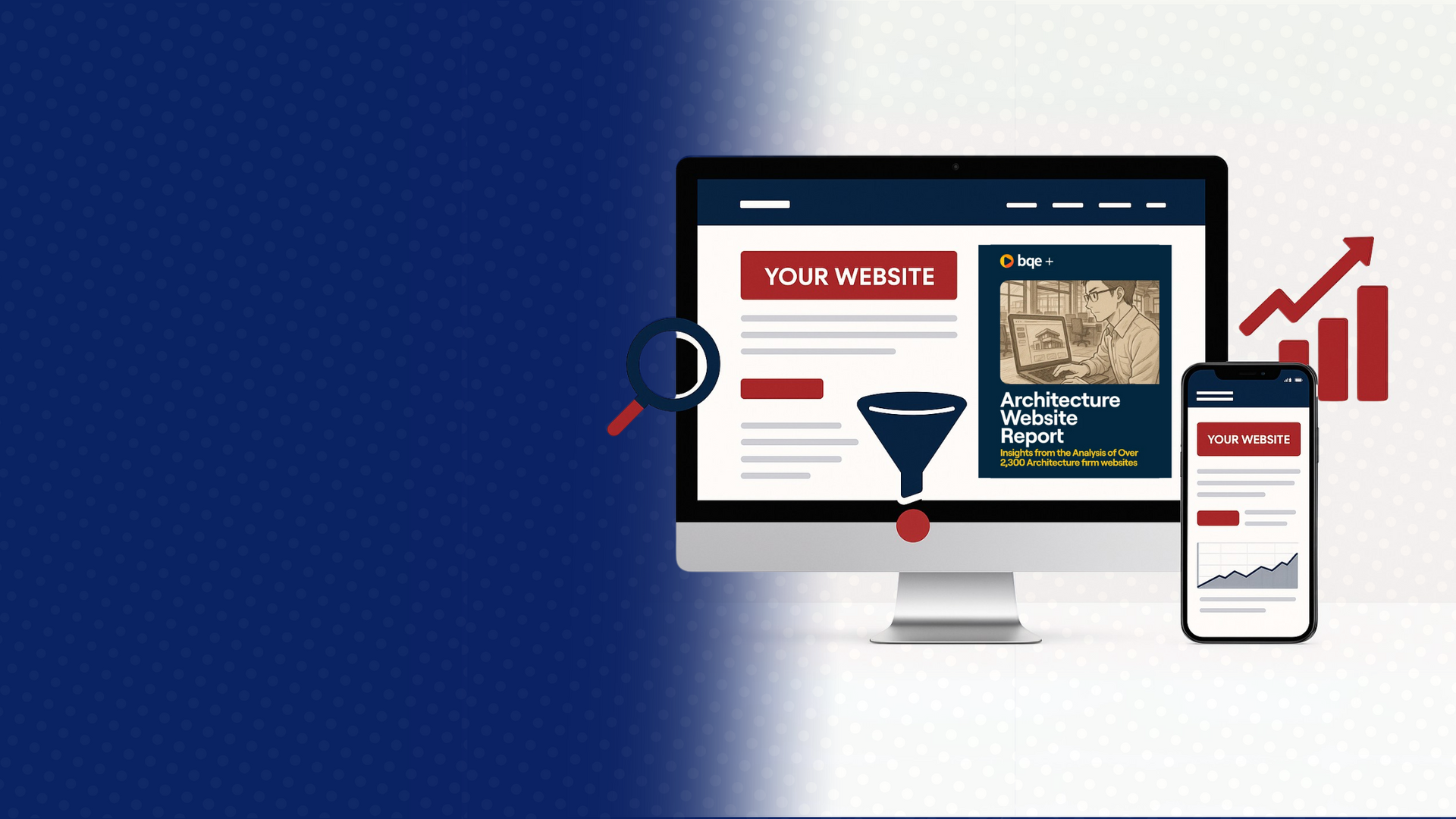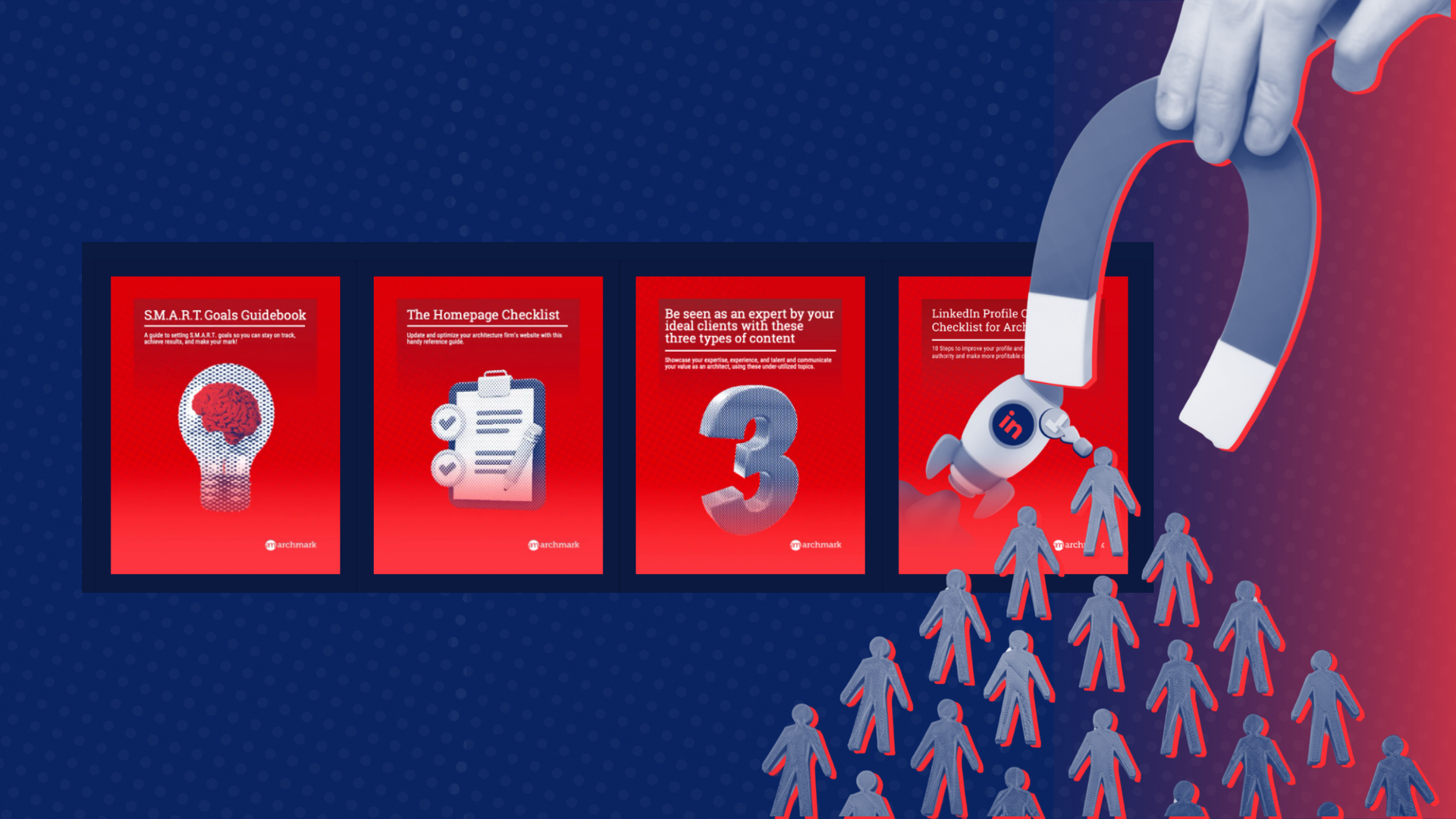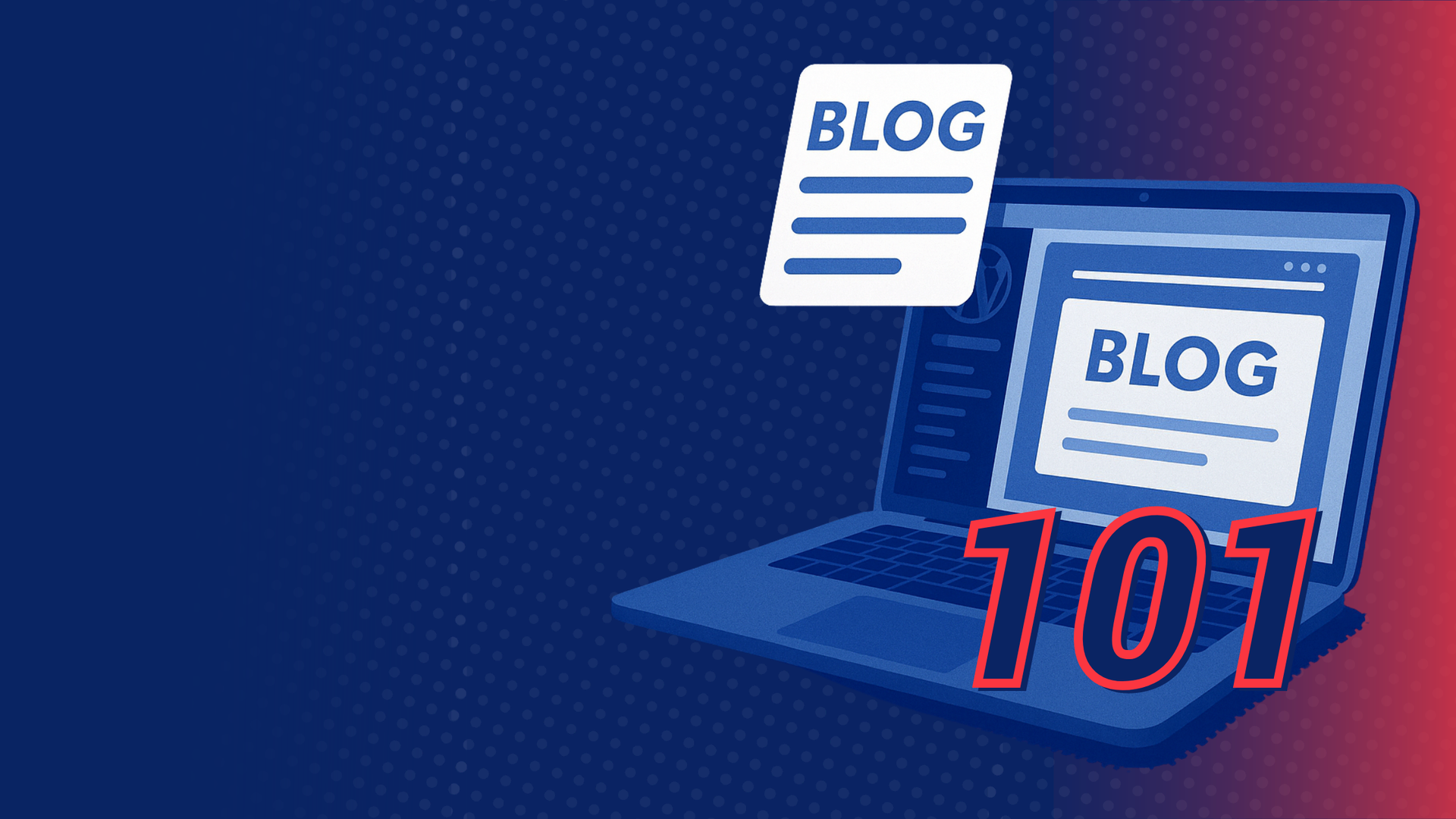Attract Ideal Architecture Firm Clients with Your LinkedIn Profile
Set Up and Use Your Linkedin Profile to Find, Attract, and Connect with Your Ideal Architecture Firm Clients
Archmark's Definitive Architecture Firm Marketing Guide to Perfecting Your Linkedin Profile.
Have your clients or prospects ever made any of the following statements?:
- “We are just looking for a set of blueprints.”
- “Don’t worry, my contractor can figure it out.”
- "I've scribbled out what I want, all you have to do is draw it up on the computer...”
- (While you are standing there, them talking to someone else…) “Thank you... I designed this home/office myself, etc...”
- or, “You must meet the builder who did our house.”
These are actual statements by architecture clients that have been said within earshot of the architect.
They are statements that completely undermine the role that architects play in the building design process.
They signal a complete lack of appreciation for the authority and expertise that architects bring to table.
And these types of statements have become so pervasive, that architects have come under threat, as an industry, especially small firms.
It’s easy to blame the clients for these statements.
But the raw truth of the matter is this, most architects are to blame for these mis-understandings.
Sorry, but it’s true.
The simple fact is that most architects do not effectively communicate their value in the design process.
How can you build high-quality marketing relationships for your architecture firm?
Marketing for architects is very different from other industries because finding new projects relies on building high-quality relationships with prospects and referrers.
But creating these kinds of relationships takes a lot of effort and time.
This makes it difficult to know the best methods or venues for attracting, finding, and connecting with the right prospects, partners and promoters.
From cold calling, to local networking events, expensive conferences, and more expensive sponsorships, where do you start?

It’s complicated to know the best methods for creating productive relationships.
If you are not familiar with LinkedIn, it may not seem like an obvious first choice for relationship building or marketing your firm.
However, if you already have a decent LinkedIn profile, it’s probably one of the first links that web searchers will find when they Google your name or your firm.
In this in-depth Architecture Marketing Guide, we will show you how to properly optimize your LinkedIn Profile to find, attract, and connect with the ideal people you want to build relationships with, to grow your firm.
You will benefit from in-depth info, detailed insights, and proven tips and techniques to use your LinkedIn profile to make a great first impression for you and your firm.
Taking these steps will help you attract and connect with better clients and projects.
In fact, in my first three months of using LinkedIn for business prospecting, I made 600 new connections, I had 30 scheduled calls, and I landed two new clients.
Learn how to Grow Your LinkedIn Network in Three Steps.
The best part was that I did all of that, on average, in 15 minutes a day on LinkedIn.
For firm owners and leaders, LinkedIn is a proven platform for connecting with potential new clients, partners who can refer business, and promoters who can introduce you to new audiences..
So let’s get started.
Table of contents
This article is a definitive guide to perfecting your LinkedIn profile as an architect.
We have tried to cover everything in as much detail as possible.
To help you navigate this article, we’ve provided an easy to use Table of Contents so you skip to specific sections or topics.
Download our 10-point Linkedin Profile Optimization Checklist.
If you just want to get started with some quick tips to improve your LinkedIn Profile, click the red button below to download our free 10-point Linkedin Profile Optimization Checklist.
This checklist is a handy reference guide to some of the keys things to consider when updating and optimizing your LinkedIn Profile.
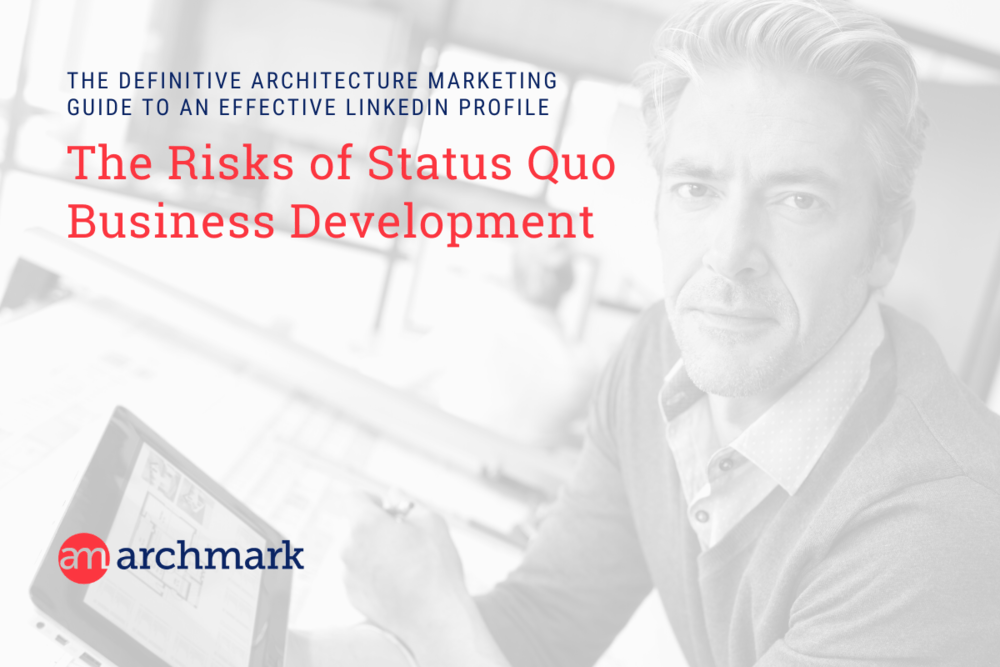
The Risks of Status Quo Business Development Approaches for Architects
01. The Risks of Status Quo Business Development Approaches for Architects
In our work with architects, we have seen many firms struggle to establish consistent, reliable processes for developing new clients and projects.
They are too focused on traditional approaches that rely on passive business development techniques.
These approaches worked great 15-20 years ago, but today there are many more firms competing for the same work, not to mention design-build and other hybrid firms are also in the mix.
There are four primary methods most architects we have spoken to rely on for new business:
- Repeat clients
- Third-party word-of-mouth referrals
- In-person networking events
- Random walk-ins and other inquiries
We want to be clear from the start, the purpose of this article is not to try to say that these methods don’t or can’t work.
Architects have relied on these approaches for generations.
You should keep relying on them, if they are working for you and your firm.
This article is intended to help you get the most out of these efforts.
As we have seen with the Coronavirus crisis, just like the economic crisis of 2008, the more you can make yourself and your firm more visible, more memorable, and more distinct, the more opportunities you will have.
But let’s look at these traditional approaches to business development and why they can present challenges for firms.
Hope is Not an Effective Architecture Marketing Strategy
Relying on Repeat Clients Can Result in Reduced Fees
Everyone knows it’s easier to sell to a happy past client than it is to find a brand new client.
But in architecture, depending on your specialty, it can be really challenging to find repeat clients who can bring you a consistent stream of new, repeat projects.
Franchises, hospitals, schools, and other types of clients may provide these opportunities.
And once you find a repeat client it’s natural to want more and more business from them.
But there are several risks involved when most of your business comes from repeat clients.
- Your key contact may move on to a new job, retire, or get fired, resulting in you losing future business.
- Projects can change scope, suddenly get scrapped, or drastically reduced in scale.
- Repeat projects can be boring, from a design perspective, Doing the same thing over and over means you can’t be creative, and it may lead to staff attrition.
- Another issue that can arise with repeat clients is the constant pressure to reduce fees.
Pressure to reduce fees can feel like being caught in a slowly tightening vise.

Repeat clients can be hard to find, and may not be reliable.
After completing one project, a repeat client may expect you to discount your fees on the second project, and again on the third, and on and on.
Meanwhile, your expenses are not going down.
Truth is, costs are probably increasing year over year, and so is the value of your experience and expertise.
That repeat client is expecting to pay less for a better trained, more experienced team, while your firm bleeds money and profit to keep them around.
Repeat clients can be great, as long as
the conditions and expectations are right, and they remain profitable.
Relying on Referrals Can Result in Unpredictable Cash Flow

Referrals can also be a great source of new business, because, usually, they come ready to work with you.
They have been recommended by a trusted resource who has said your firm would be a great choice.
But they can also present huge challenges and problems for your firm.
Referrals may come with pre-determined price expectations, based on whomever referred them.
They may also come with a sense of obligation, on your part, to make the referrer happy.
(Referrals are great, but they are rarely consistent or predictable.)
They may also come with a sense of obligation, on your part, to make the referrer happy.
In fact, more than one architect has told us how they have taken on referral projects to protect their referral relationship and did not want to risk future referrals going to someone else.
In some cases, the architects knew these jobs were not a good fit for their firms, but did the jobs anyway, often at a loss, or resulting in a bad situation where the client was not happy.
Taking on unsuitable jobs to guarantee future unsuitable projects?
Does that sound like a sound approach to building a healthy and sustainable firm?
I can’t deny that referrals can present amazing opportunities for firms, but they are far from predictable.
The truth is, that you never know when referrals are going to come your way, and if they are going to be the right project for your firm.
And maintaining referral relationships can take a lot of time, effort, and money.
Relying on Referrals Can Result in Unpredictable Cash Flow

Many architecture firm owners tell us that in-person networking events, conferences, and other one-to-one channels can be a great source of new business.
However, most of these activities are conducted by owners, principals, or partners and other firm leaders.
Have you calculated the hours you spend at in-person events, trying to drum up new opportunities, and compared that to billable hours?
We have spoken to many frustrated architects who feel obligated to attend in-person networking events which are time-consuming and costly, but yield inconsistent results.
(Networking ROI is very difficult to measure and track.)
First thing you learn in marketing (and, yes, these activities are considered marketing) is that you have to know your return on investment (ROI).
Such efforts can be difficult to measure and track, and you can’t manage what you don’t measure.
But even when you can measure these activities, often the ROI doesn’t justify the time, money and effort spent chasing these opportunities.
Relying on Walk-ins Can Result in Missed Opportunities
“Walk-in” clients used to be very common.
Once upon a time, someone would realize they needed an architect and they would find the 2-3 local architects listed in the Yellow Pages, and they would plan a visit.
That was before the internet.
Today, there are more than 65,000 keyword searches for the top 20 keywords related to ‘architect near me.’
And these are just the generic search terms.
Most people search based on their location, so if you add in all the localized searches, like “theater design nashville,” “modern home architect los angeles,” or “architecture firms in nyc,” we’re easily talking about millions of searches each month.
(Walk-ins are are rare compared to web searches.)
By the time someone calls your firm, they have usually researched several firms, they have looked through your website and read all your Google reviews.
Unfortunately, based on our evaluations of more than 400 architecture firm websites,
75% of architects have an inadequate web presence. If you are not making a great impression online, then you are not going to capture those opportunities.
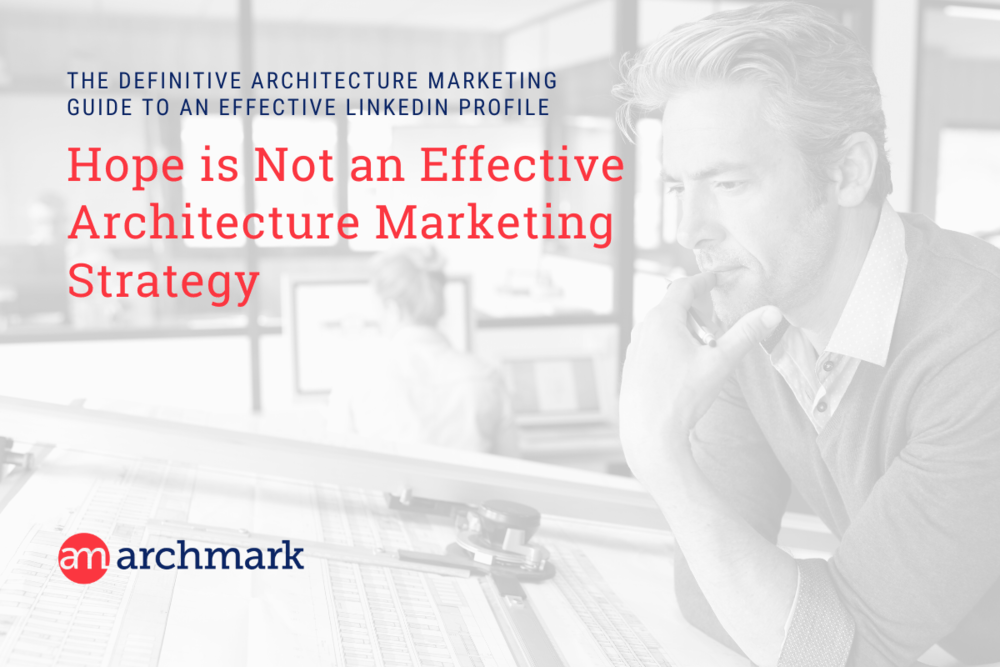
Hope is Not an Effective Architecture Marketing Strategy
02. Hope is Not an Effective Architecture Marketing Strategy

Whenever we meet with an architecture firm owner looking to increase their new business opportunities, we always see one consistent thing:
They often tell us they find most new clients as a result of their reputation and relationships.
That they don’t do any marketing.
We are not going to argue with established convention.
However, if you’d say the same thing, please answer the following question honestly:
What is your method for building productive and profitable relationships?
(Hope marketing is a nice word for Passive Business Development.)
If you do not have a clear understanding of how you build relationships in a consistent, repeatable, and scalable way, then you do not have a method.
You are relying on what we call Passive Business Development.
You are simply hoping that your reputation and relationships will somehow bring you all the business you need.
And here lies the deeper problem:
Hope is not a strategy.
At best, it’s wishful thinking.
At worst, it’s pure naïveté.
It’s certainly not a consistent, repeatable, or scalable way to generate new projects.
But what if you didn’t have to rely on hope?
A Better Way to Market Your Architecture Firm
What if there was a better way for you and your architecture firm:
- To increase your visibility in the markets you serve?
- To be known as a ‘go-to’ architect by showcasing your experience, expertise, and talent?
- To attract and connect with your ideal future clients?
What would it mean for you and your firm’s ability to gain better, higher-profile clients and projects if you had a way to get in front of desirable clients on a consistent basis?
Keep reading to learn how an effectively optimized LinkedIn profile can help you be.
Are You Marketing Your Architecture Firm In Too Small of a Pond?

When I was young, I used to go fishing with my Grandpa. He loved to fish and he would often take me with him to the stocked ponds at the local fish and game association.
The fish were less than spectacular, but it was nice to spend time with him.
One day, my Grandpa surprised me when he took me to see his new boat. It was a beautiful 19” Lyman, perfect for catching Perch and Walleye on Lake Erie where we lived.
I remember him saying, “If you want to catch bigger fish, you have to fish in a bigger pond.” And we certainly did.
Our summer days were much more exciting, drifting on the lake and hauling in our catch. We never went back to the fish and game pond.
(“If you want to catch bigger fish, you have to fish in a bigger pond.” - Grandpa)
Read about the Five Architect Marketing Building Blocks to Grow Your Firm
here!
I share this story because it underscores an important point.
If you are only looking for new business in the ‘small pond’ of your in-person, referral, or face-to-face network, you are probably fishing in a pond that is just too small.
More than 660 million business professionals have LinkedIn profiles.
In the United States alone there are 167 million LinkedIn users - that’s half the entire U.S. population. (source: omnicore)
That’s a big pond with a lot of fish.
LinkedIn allows you to greatly expand your professional network, not only to include potential prospects but also to connect with partners and influencers who can connect you with their audiences.
As we said at the start, we often hear from architects that reputation, relationships, and referrals are important to finding new clients, and we absolutely agree with that.
If you’re able to increase relationships with prospects, partners, and promoters, your firm will be in a better position to improve and grow.
However, a big challenge of building quality relationships is getting in front of (and connecting with) your ideal audiences.
How do you do that effectively and efficiently?
This is where LinkedIn excels more than any other social platform.
LinkedIn makes it easy to find, connect, and communicate with the people you want to meet.
And the most important part of using LinkedIn is to make sure you're making a great first impression.
This starts by taking a close look at your LinkedIn profile.
Go ahead, take a look at your LinkedIn profile.
Does it...
- Effectively communicate who you are?
- Showcase your skills, expertise, and experience?
- Explain how you and your firm can help them achieve their objectives?
If you don’t know, or you’re not sure, keep reading.
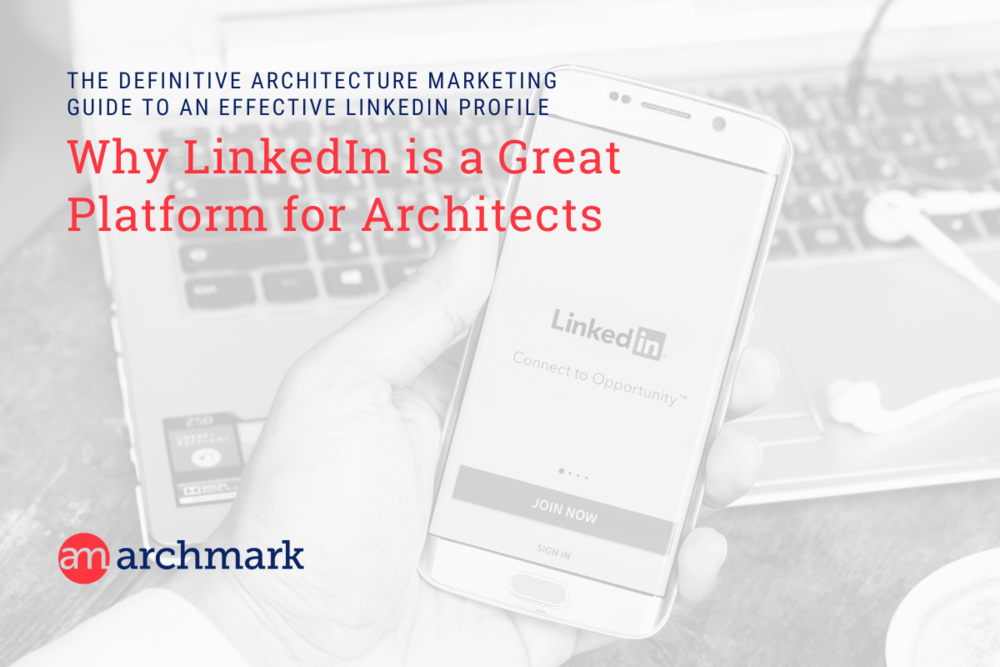
Why LinkedIn is a Great Platform for Architects
03. Why LinkedIn is a Great Platform for Architects
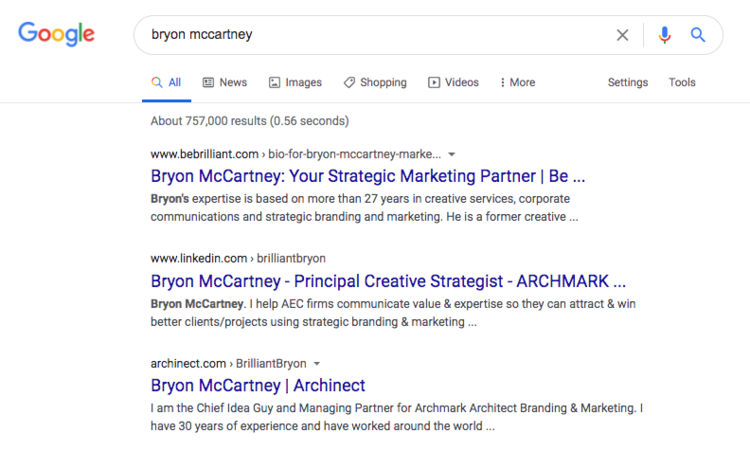
Google your name.
Go ahead, I’ll wait.
If you have a LinkedIn profile that is somewhat complete, your profile will likely appear on the first page of search results for your name, and most likely, when you search your firm’s name as well.
How do we know?
We asked 76 architects “Does your LinkedIn profile appear on the first page of search results for their name?” A resounding 82% said yes.
There are exceptions. For example, if you share a name with a celebrity or a historical figure or you already have an established and diverse web presence on several other platforms, LinkedIn may not be on the first page.
But, if you make an effort to improve your profile, it will.
LinkedIn is very powerful when it comes to search results.
When someone is interested in doing business with you, or even if they are referred to you by a trusted resource, they are going to Google your name.
It’s very likely that they will end up on your LinkedIn profile page.
Why?
Because they know that when they visit your LinkedIn profile, they can find out a lot about you.
- They can see your mutual relationships.
- They can see where you have worked in the past.
- They can see your recommendations.
- And they can see other information you’ve shared.
Your LinkedIn profile is one of the first places people are going to go to learn more about you.
Don’t you want to make sure they get a great first impression?

If your profile is incomplete, out of date, if it’s not clear what kind of value you can provide, or if there are major gaps in your work history, what kind of impression will that make for your potential prospects?
LinkedIn is used by so many professionals already, it’s the natural place to go when researching new contacts and people you may be thinking about doing business with.
For some, this may seem like stalking, but in reality, it’s just part of performing due diligence.
If I’m referred to another business, of course I’m going to look them up online. Most likely, I’ll go find their company page on LinkedIn, and look up their employees as well.
I want to know who these people are and make sure I’ve done my research to properly vet them before I invest time in contacting them.
I will also review their connections to see who we both know. And, I’ll look at their work experience, where they went to school, what certifications they have. I’ll also check to see if they have received or given recommendations.
If basic information is missing, I may not even bother contacting them.
However, if they have a complete profile and I like what I see, I will likely consider that as validation of the referral, and I’ll be more likely to reach out to them.
Whether you like it or not, we live in an era where our online personas play an important role in how we connect with others.
The Yellow Pages has been replaced, but the upside is that you have control over what you share on LinkedIn.
If you want to make a great first impression, you have the power to do so.
But failing to do so can result in missed opportunities.
Ready to get started?
If you’re ready to jump in and improve your LinkedIn Profile, click the button below to download our free 10-Point LinkedIn Profile Checklist. We’ve packed it full of quick tips to help you update and optimize your LinkedIn Profile.
04. The Ultimate Guide to Your LinkedIn Profile
Now that we understand why LinkedIn is such a great platform for Architects, let’s dig further into how to complete your LinkedIn profile.
Unlike other social media platforms, Linkedin is about business, and it’s important that you take the right approach when completing your profile.
Before you start diving into your profile and making changes, it’s important to take a step back and answer three important questions:
- What are your goals (for your LinkedIn profile)?
- Who are you trying to connect with?
- Why should they care?
Let’s dig in.
What are your goals (for your LinkedIn profile)?
This is very important, keep in mind that you’re not writing your profile for anyone and everyone.
You are writing it for those few people who are your ideal connections.
You are definitely not writing it to impress other architects.
It’s important that your profile is interesting and engaging for the people you are trying to connect with.
Think about writing your profile as helping your connections answer any questions and concerns they may have about you firm.
You have certifications, experience, and expertise that make you uniquely qualified to solve their problems.
What can you include in your profile that will help you separate yourself from other architects they may be looking at?
The more you can speak to your ideal connections, the more questions you can answer, the more success you’ll have in connecting with them.
Who are you trying to connect with?

You can’t know what to write if you don’t know who you are writing for.
Who can bring you your dream projects?
The more clarity you have about who you are trying to write your profile for, the more success you’ll have in engaging them.
What would your ideal connections want to know about you or your firm?
For some, it may be your qualifications.
For others, it might be recent projects you’ve completed.
Others may gravitate towards previous work experience.
However, for some, the decision to contact you may rely on something more arbitrary or random.
It could be something simple like the fact that you attended the same school that they just sent their oldest child to attend.
Often, why someone contacts you is not clear, but it can come down to a simple feeling of familiarity that may not be immediately apparent to you or them.
That’s why we recommend reviewing your profile at least once every three months.
Make sure that you are periodically fine-tuning your profile to speak to you audience(s) as you gain experience with their issues.
Why should they care?
Do not think about completing your LinkedIn Profile the same way your would if you were completing your resume.
As a firm owner or leader, you are not applying for a job.
Your audience doesn’t want know every single detail of your work history, every single award you have won, or article you have been featured in.
They want to know whey they should care, why keep reading?
If your profile needs to convince them that you can solve their problem, and that means it can’t all be about you.
The issue is that people are busy, they they are searching LinkedIn to quickly find an architect like you.
If your profile does not immediately convey the right message, it’s easier to go back to LinkedIn search and find the next firm.
As you are completing your profile, try to get into the mind of the people you want to connect with.
Try to anticipate what they may want to find on your site.
What information do they want to know about you and your firm?
What questions can you answer for them, to show them that you understand their problems and concerns?
Completing Your LinkedIn Profile
Your LinkedIn profile is organized into eight distinct sections of information, some of those sections contain additional sub-sections:
- The Intro Section
- Name
- Profile Photo
- Headline
- Cover Image
- The About Section
- About Summary
- Expanded About Section
- The ‘Featured’ Section
- The Background Section
- Work Experience
- Education
- Licenses & Certifications
- Volunteer Experience
- The Skills & Endorsements Section
- The Recommendations Section
- The Accomplishments Section
- Publications
- Patents
- Courses
- Projects
- Honors & Awards
- Test Scores
- Languages
- Organizations
- The Interests Section
Now let’s go through each of these sections and get to the details of the 8 Steps to creating, updating, optimizing your best LinkedIn Profile.
05. The LinkedIn Intro Section
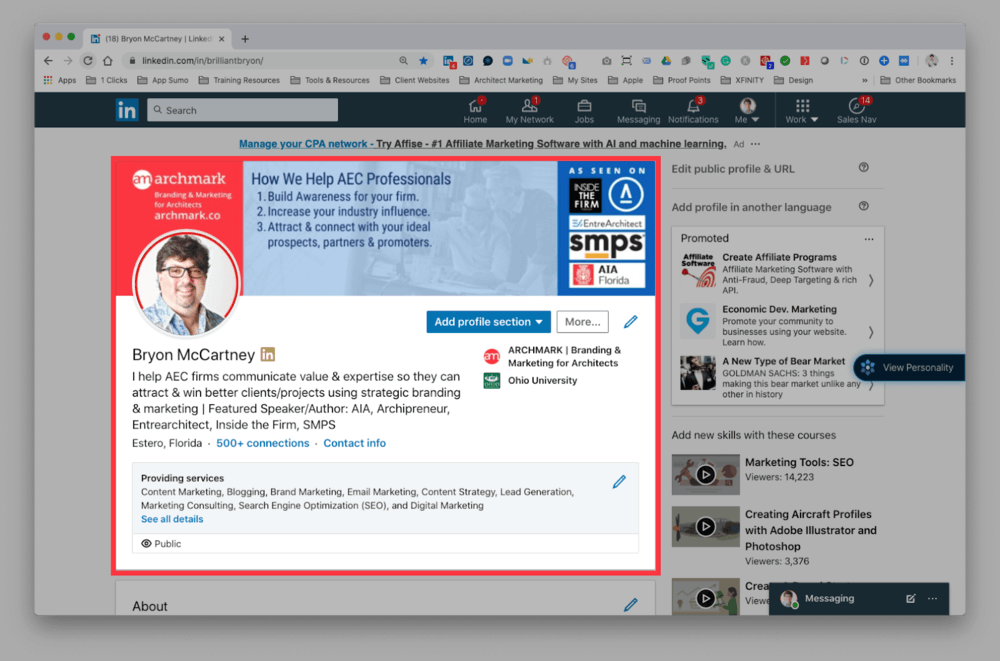
Your LinkedIn Profile Intro Section
Your LinkedIn Intro Section includes Your Name, Your Profile Photo, Headline, and Cover Image—all the essential pieces to making a great first impression.
LinkedIn Profile: Your Name
LinkedIn allows you to enter your first and last name, and, optionally, a former name - for example, maiden name.
If you spend enough time on the site, you’ll see that some people use their name fields to include middle names, titles, and other information.
Because architects are licensed, some feel the need to include their certifications (e.g. AIA, LEED AP, NCARB, etc.) in their name fields.
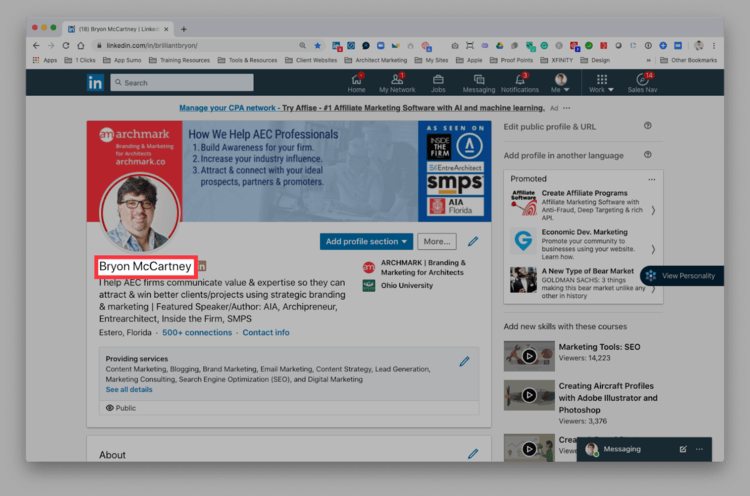
We do not recommend doing this. It’s best to use the first and last name fields for their intended purposes, your first and last name.
(Your LinkedIn Profile Name)
LinkedIn provides the Licenses & Certifications section for your credentials.
When you fill your first and last name fields incorrectly, this makes it much more difficult for people to find you when they search for you on LinkedIn.
Most people are going to search for the first name ‘John,’ last name ‘Smith,’ not first name ‘John,’ last name ‘Smith AIA, NCARB, LEED AP.’
If you really must have those acronyms after your name, do just that, add them after your last name in the ‘last name’ field of your intro section. Do not put your first and last name in the first name field, and your credentials in the last name field.
Also, this is a good time to point out that you should not use a personal profile as your company/business profile page on LinkedIn.
Second, LinkedIn provides the option to create a company page for your firm. We will cover company pages in a future article.
LinkedIn Profile: Profile Photo
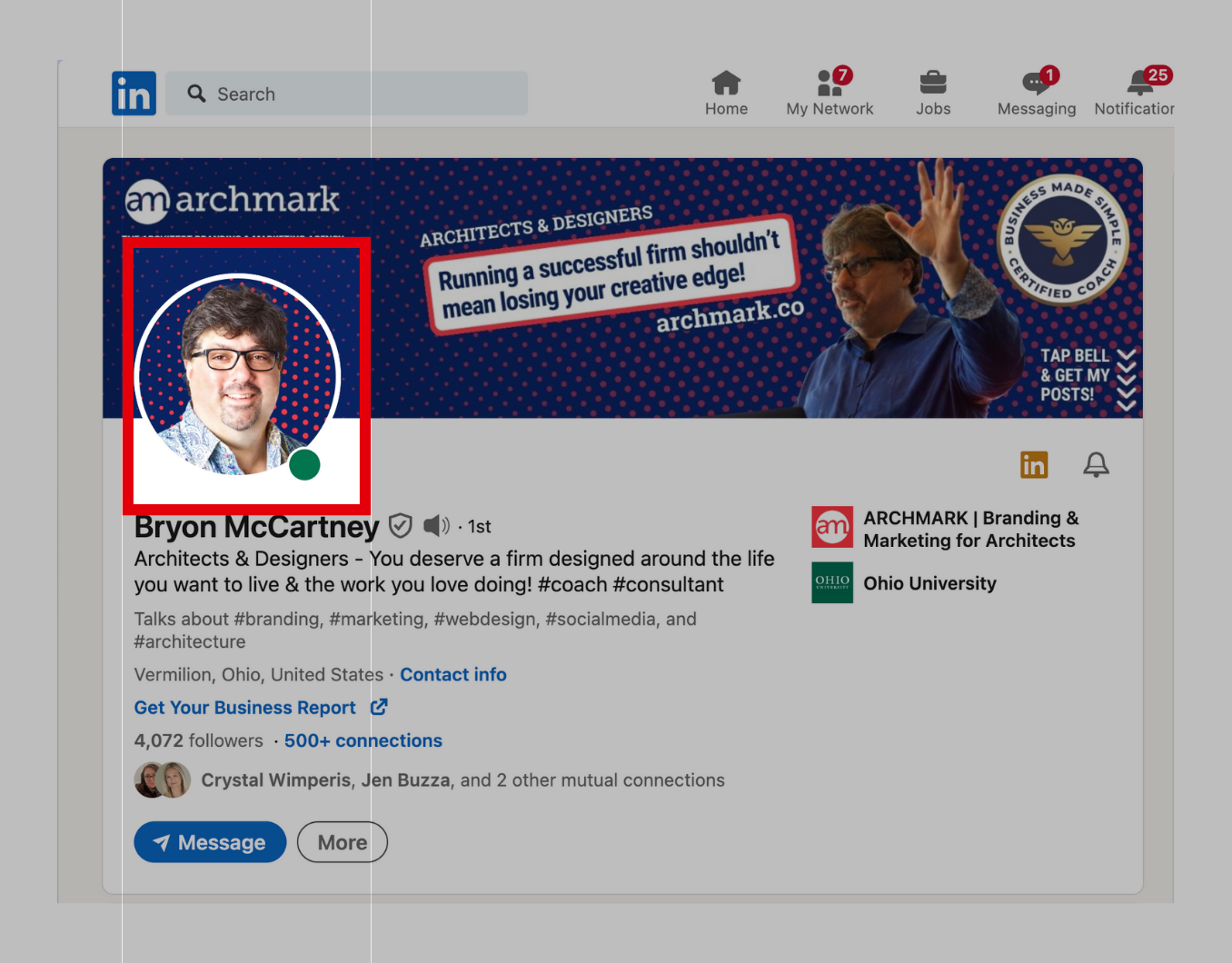
If you want to make a great first impression, make sure your profile photo helps your cause.
Don’t try to be clever or cute, this isn’t a place for pictures of your office cat, your firm’s logo, or a photo of you and your employees at a team-building exercise.
Don’t leave it blank.
If you do, most people won’t take you seriously, and some may assume your profile is fake or has been spoofed by a scammer.
Your profile photo is very important because it will often be the first image someone sees of you.
You want to make sure it’s professional, and that they are able to recognize you from your picture when they see you on a ZOOM call or at an in-person meeting.
(Your LinkedIn Profile Photo)
What you are aiming for is a professional portrait - what is commonly referred to by photographers as a headshot.
In fact, your ideal LinkedIn profile photo should be a straight-on angle of your face, with a plain background, and your face occupying about 60% of the frame, similar to a typical passport photo.
To help you perfect your profile photo, please download our free LinkedIn Profile Photo Checklist.
You can give this document to your photographer, or follow the instructions to create a good LinkedIn profile photo yourself.
LinkedIn Profile: Profile Headline
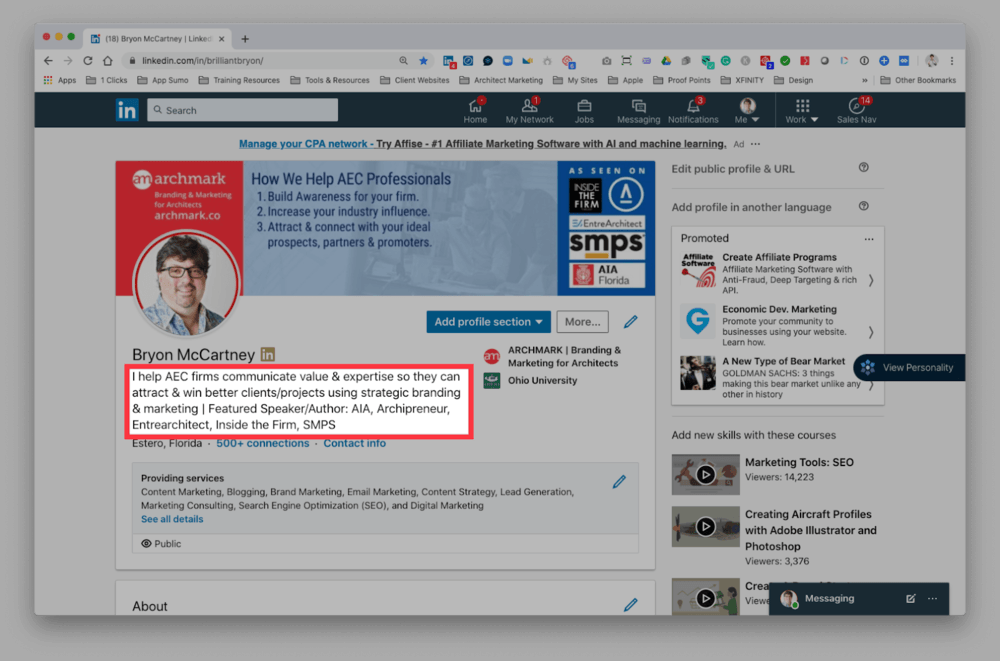
When someone visits your profile, or you appear in the LinkedIn feed (see below image), they will see your Profile Name, Profile Photo, and an abbreviated version of your Profile Headline together.
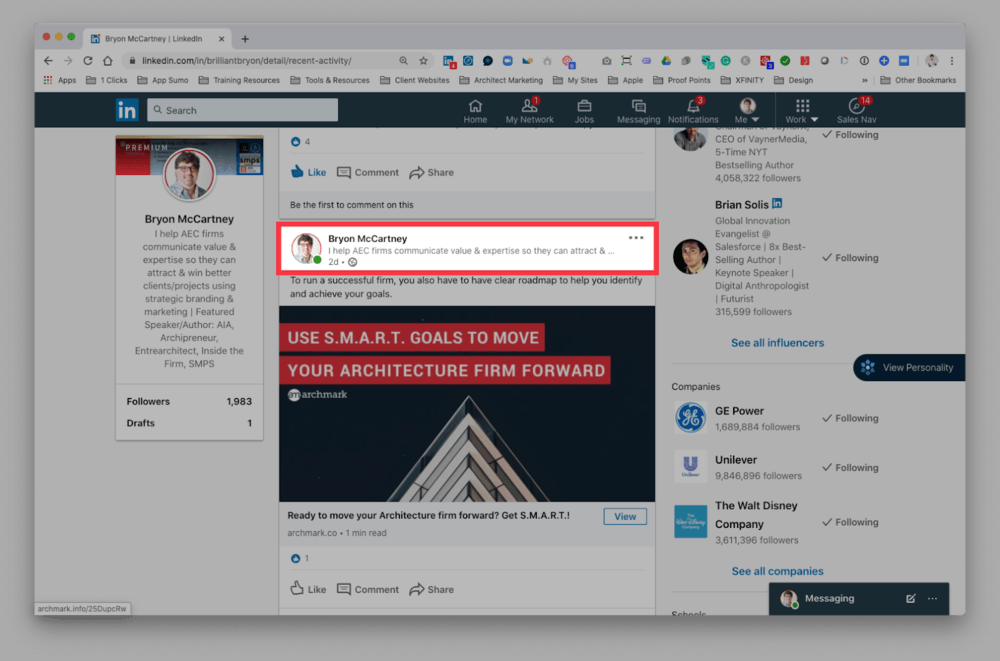
How your profile appears in the LinkedIn Feed
On LinkedIn, many people simply use their Profile Headline as a job title, but this is a lost opportunity.
When LinkedIn users are looking at your profile to see if you are someone they want to connect with, they’ll scan your profile and the first two things they’ll see are your photo and your headline.
They can easily scroll down the page and view your employment history if they need to find your job title.
But when they are scanning the top of your profile, what they really want to know is what you do and why they should care.
If all it says is ‘Architect’ then you’re not going to grab their attention.
But if it says something like “Award-winning modern luxury home designer for self-made connoisseurs of taste who want to enjoy a coastal lifestyle in Florida,” well, that tells them exactly what you do, who you do it for, why you’re different, and what you provide as a benefit.
So much more compelling, right?.
When writing your headline, remember this formula: Keywords + Target Audience + Benefit = Awesome Profile Headline
Keywords
The best keywords to include in your headline will be those that will match up to what your target audience would search for when searching for an architect like you.
Be specific. If you work on commercial projects, and that is the type of work you want to attract, be sure to include ‘commercial architect’ in your headline.
Target Audience
Mention your target audience so they know that you work with them specifically. If you want to design dental practices, include the words ‘dentists’ or ‘dental practices’ in your headline.
Benefit
Including a reference to the type of benefit you can provide to your clients is really helpful and will grab their attention. If you consistently save restaurants tens of thousands of dollars in build-out costs, include that.
Make it clear why your ideal connections would want to connect with you.
Three More Tips for Your LinkedIn Profile Headline
Here are three additional tips to make the most of your LinkedIn Profile Headline:
- The first 80 characters of your headline show up in the abbreviated preview that LinkedIn users see in their news feed when you share posts or comment on others’ posts. Be sure to use these characters strategically by keeping the most important details in those first 80 characters.
- When editing your headline on a desktop computer, LinkedIn only allows about 120 total characters of text. However, if you edit your headline using the LinkedIn App on your mobile device, you’ll have nearly double that amount of text to work with.
- Your headline is used to match your profile with searches on LinkedIn. Adding relevant hashtags to your profile headline will help you get found by people looking for your services. But don’t go overboard, three hashtags are enough.
Make sure to put time and effort into writing a great headline, don’t be afraid to experiment and change it from time to time to see if you get more traffic. The more you can fine-tune your headline, the more you’ll find that your target audience finds and connects with you.
LinkedIn Profile: Cover Image
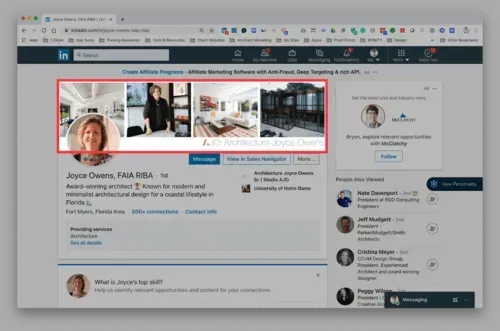
Your cover image is at the top of your profile, behind your profile photo.
Unfortunately, on LinkedIn, we often see profiles with the standard boring blue cover image.
This is a lost opportunity to make a great VISUAL impression.
All LinkedIn profiles are pretty much the same, but your cover image is a great way to catch someone’s attention.
We recently redesigned the profile for our client, Joyce Owens. In her cover image (above) we added a second photo of her in her office and three images from projects she’s recently completed. We also added her logo to provide a clear connection to her brand.
You can get very creative with your cover image, just remember to design the image to the recommended size of 1,128 x 191 pixels to make sure everything looks and fits good.
06. The LinkedIn About Section

The second section on your LinkedIn profile is known as the ABOUT section.
When you first open your profile, you’ll notice that your About section only displays a short teaser.
This ‘preview’ displays about two and a half lines of text for a maximum of about 200-250 characters or about 25-42 words.
However, if you click the “SEE MORE” link in the section, this text box expands to accommodate up to about 2,600 characters.
This gives you a lot of room to work with and you should use every character.
Like your headline, this section is used to match your profile with search queries from prospective clients, partners, and promoters who want to connect with experts like you.
Let’s examine this section in a bit more detail.
In the expanded About Section, you can go into more detail about how you help your clients.
Your About Section is a unique part of your profile in that there is no real expectation or definition for what the About Section has to cover.
This gives you a lot of freedom.
You can make it about your firm. You can make it about you.
However, if you really want to engage your ideal future clients, I’d advise you to make it about them.
When we write About Sections for our clients, we try to follow a simple 3-step formula: Problem + Agitation + Solution
Problem
With the first step, we want our ideal clients to know that we understand their pain. That we have been there and done that. Stating the common problems your target audience may struggle with is a great way to demonstrate that they have found the right architect.
The key thing to remember about stating a problem is that it does not have to be something that they have experienced themselves. It can be something that they simply want to avoid.
Here’s an example:
Designing a commercial office building is complicated enough, you don’t need an architect who’s complicated as well.
The fact that you’re raising their awareness of potential hurdles and pitfalls will give you immediate credibility, and help you to be seen as an authority, especially if other architects are not talking about these problems - and let’s face it - most are not.
Agitation
The next step is to agitate the problem by mentioning the consequences that may result if the problem is not addressed.
When you agitate the problem, you want to provide real-life examples. It helps to add statistics or share a real-life story - aim to stir emotions.
For example, if we continue from the problem statement we used above, we could agitate this problem with the following:
Choosing the wrong architect can result in unexpected delays, cost overruns, and/or a final build that doesn’t match your vision.
Part of your expertise means that you understand and can anticipate the problems they may come up against. Getting out in front of their concerns, and raising the potential pitfalls, demonstrates your understanding of their situation.
The more you can fine-tune the agitation to the target audience you want to attract, the more they will believe that you are capable of helping them.
Solution
Now that you have demonstrated that you understand your target audience’s problem, and you’ve communicated your understanding of the potential consequences, you’ll want to offer your solution.
This is how you can position your firm as uniquely able to solve their problem.
Continuing on from our examples above, a solution could be something like:
XYZ Architects provide a simple, 5-step project development process to help reduce uncertainties, reduce costs, and ensure that your final build is exactly what you envisioned.
For architects, there are often opportunities to ‘package’ parts of your services.
Packaging, or naming your solution, is a way to make it more memorable.
Most architects refer to their first client meeting as an “initial consultation.”
If you are the client, and every firm in town refers to that first meeting in the same way, they’re going to sound all the same.
However, if your firm refers to it as ‘Scope & Vision Session’ the client is probably going to assume that they are getting something a bit different, or, at least, somewhat unique.
You might scoff at this, and think that architects should all use the same terminology, but this is how your services become commoditized.
There was a time that coffee was just coffee. You could get a cup for less than $1 in most any restaurant, deli, or local coffee shop. Then Starbucks came along, and now we call coffee things like Venti Latte, Doppio Espresso, Grande Frappuccino. Not only that, but coffee also costs much more than it used to.
If you want your services to be more memorable, and if you want to charge higher fees, you have to find ways to be more unique.
One of our clients refers to his approach to client service as “Concierge Architecture.” The name provides potential clients with an immediate and recognizable concept that helps them understand the high-quality and attention to detail that his firm provides.
So, in his case, his solution statement is: ‘Our Concierge Architecture service minimizes the complexity of managing your project by giving you one point of contact that can provide you any information you need about your project, whenever you need it.’
This solution statement gives a potential client an immediate idea of what is on offer and how it will benefit him.
LinkedIn Profile: About Section (aka: the summary)
As mentioned earlier, when someone comes to your profile page, the About Section shows just a quick summary. There’s only a short preview of about two and a half lines of text.
This short preview is really important.
You want to use this text to tease your profile visitors to click the ‘SEE MORE’ link and expand this section to get the full text.
To do that, first and foremost, make sure you include a call to action on the third line of text to get them to click that ‘SEE MORE’ link.
Something simple like “CLICK “SEE MORE” TO EXPAND” works pretty well.
For the first two lines of text above the call to action, try to write something compelling or interesting enough that your visitors will get curious and click to expand the section.
A great way to do that is to show your ideal future clients that you understand their pain points, here are some ideas:
- Are you tired of working with architects who put their egos before your needs?
- Have you always dreamed of a waterfront home, but don’t know where to start?
- Designing a building is complicated, you need an architect who can make the complex easy for you.
Again, think about your ideal future client and get inside their heads.
Ask yourself (or ask them!) what would make them click that SEE MORE link?
07. The LinkedIn Featured Section

Like the About Section, the Featured Section of your profile is somewhat unique.
It gives you the opportunity to post and share selected content. There are no expectations for this section, so you are free to include whatever you want.
This is a great way to highlight your firm’s articles, portfolios, videos, and other content, right here on your profile.
In fact, you can share several different types of content in this part of your profile:
- You or your firm’s LinkedIn posts
- You or your firm’s LinkedIn articles
- Links to your firm’s website pages (like your blog or portfolio)
- And you can upload media (PDFs, photos, documents, and presentations).
This is a great way to add some visual interest to your profile, as this section also provides large thumbnail previews of the content you share.
We highly recommend using this section creatively to show off your unique style and help your profile standout.
08. The LinkedIn Background Section

This section is all about showcasing your experience and expertise.
Work Experience
We highly recommend keeping your work experience up-to-date.
You don’t have to retrace every step in your career history, but it’s best if there are no unusual or unexplained gaps in your work experience.
When writing your work experience, do not approach it as you would a resume, especially if you are a firm owner or in a senior role.
In fact, if you are a business owner or senior executive, I recommend using this section to provide summaries of past positions, but use your current position to explain your firm, the value you provide and the different roles or services you offer.
A really cool feature of the Work Experience section is that you can add multiple entries under the same firm.
This is a way of ‘hacking’ the Work Experience section to add descriptions of different services your firm offers.
You can also add media to these entries, allowing you to provide images and links to examples of your work.
I use this to add portfolio images or featured media appearances on my profile.
Education
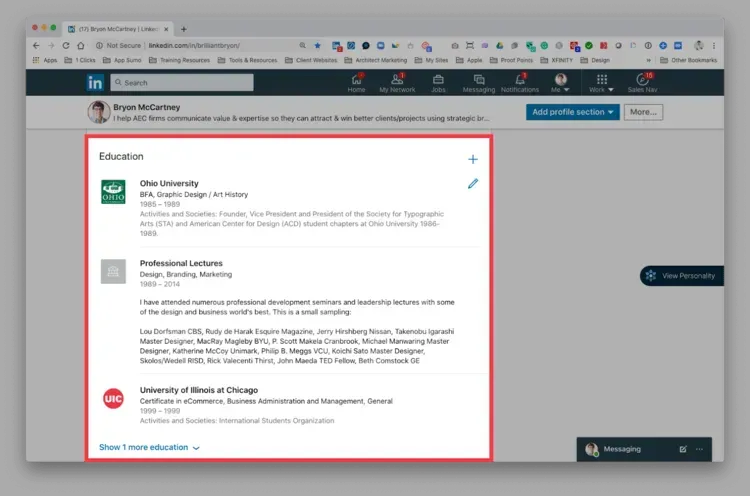
Completing your education section is a great way to showcase your training and the schools you’ve attended, but you don’t need to go overboard.
We recommend that you mention any completed undergraduate or postgraduate studies and degrees. Consider including any other significant education-related experiences you want to share.
Here’s a good tip. When entering the school field on your profile, you’ll notice that LinkedIn will offer you pre-filled options for most educational institutions.
Be sure to select your school from the options provided.
Doing so will make you a member of that institution on LinkedIn. This will make it easier for fellow alumni to find and connect with you, and this can be really helpful for general networking as well.
Another tip, when you connect to your school, swing back up to the top of your profile, and open the intro section. There is an option to “Show education in intro” and this gives you a chance to share your school’s logo in your profile.
Again, this can be helpful when connecting with classmates, but also with prospects, especially if you have attended a prestigious school.
Licenses & Certifications
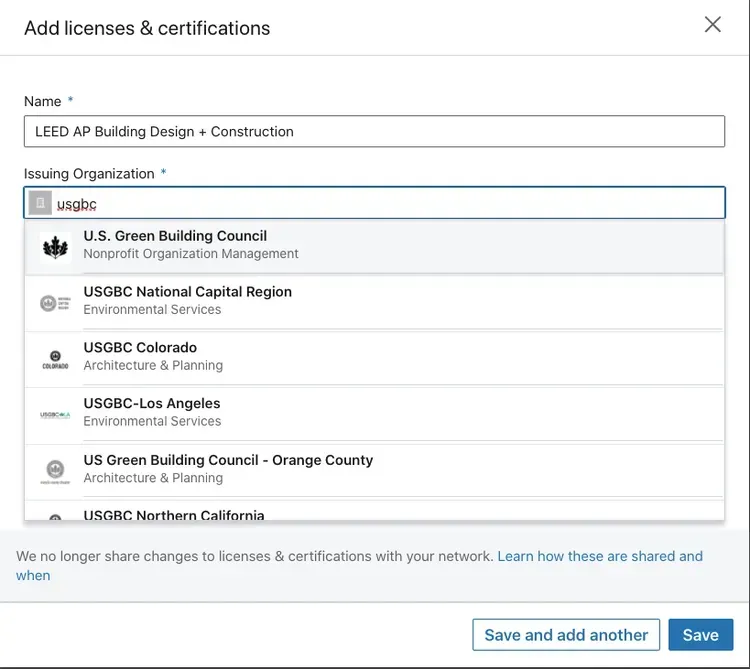
As an architect, you need to be licensed and certified - this section is the best place to share your licensing information.
And like they say, if you have it, you might as well flaunt it.
When adding certifications and licenses to your profile, be sure to select the correct “Issuing Organization.”
Most professional licensing organizations are in LinkedIn’s database, and selecting the correct one will allow you to display their logo under your certifications listing, giving your profile more credibility.
Volunteer Experience
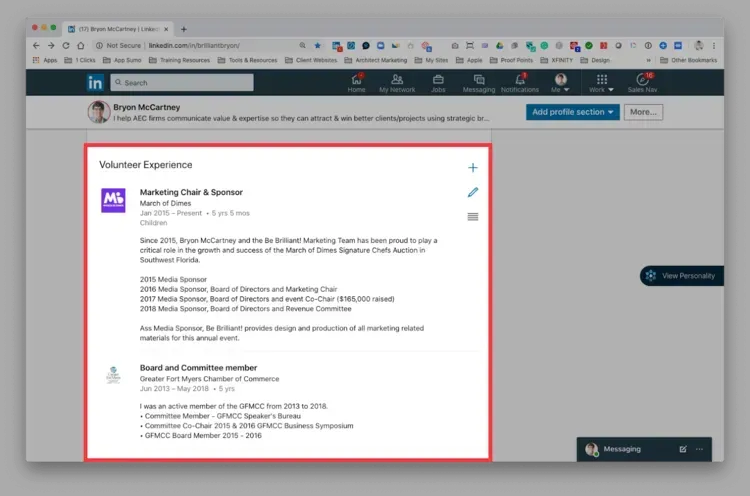
This section gives you an opportunity to share your non-profit and community volunteer experience.
Depending on your experience, and whether you feel it is relevant to your ideal future connections, you may choose to disregard this section.
However, if you have contributed to well-known organizations, or, for example, you work with a lot of non-profit clients and you want to showcase your non-profit experience, this is a great section to complete.
I like to keep my profile as full as possible because you never know when someone might see something that is relevant to them, and that could make all the difference in them connecting with you.
In fact, I have had people reach out to connect with me because of my volunteer experience. It never hurts to share this type of experience, especially if it’s with a large national, or well-known regional or local organization.
09. The LinkedIn Skills & Endorsements Section
In this section of your profile, you can list up to 50 skills. The Top 3 will be displayed, and the remaining 47 will be shown when someone clicks the “Show more” link at the bottom of this section.
Endorsements
Visitors to your profile can ‘endorse’ you for your skills and LinkedIn will display a number next to each skill designating how many endorsements you’ve received.
Once you exceed 99 endorsements for any given skill, the counter will display “99+,” no matter how many more endorsements you receive.
Endorsements are a way to show someone some public appreciation on LinkedIn. Similar to commenting or liking their posts or articles, this is a way to ‘like’ their profile.
This is a great way to get validation from your connections.
I regularly ask my others to endorse me for my skills. I also endorse others, and frequently, when I do, they will endorse me back as a thank you.
Skill Quizzes
The Skills & Endorsement section also provides the ability to take skill quizzes.
Skill quizzes usually pertain to software tools or programming languages, in fact, you can take quizzes for architectural software, such as AutoCAD, Revit, and Sketchup.
Quizzes are different from endorsements in that you have to get a satisfactory score on a timed test, in order to display them on your profile.
You’ll have about 15 minutes to answer 15-20 questions and to pass, you’ll need a score in the 70th percentile.
Once you pass one of these skill quizzes you’ll then see an official “badge” which signifies that you have passed that test.
On my profile, I have badges for Adobe Illustrator & Photoshop, and Apple’s Keynote.
I am often asked about the Skills & Endorsement section. For some, they think it’s a waste of time to spend energy on this section, because why should it matter if your friends and followers vote to endorse you for underwater basket weaving?
On the other hand, most people visiting your profile are endorsing you because they believe you have these skills or have experienced your expertise in some way.
So, why not rack up those endorsements?
It’s one more way to display your proficiency through your profile. Take advantage of it.
10. The Recommendations Section

This section is one of my favorite sections on my LinkedIn profile. I love getting recommendations from people I have helped, and I’m honored when they take time to do this.
Most people don’t request recommendations on LinkedIn and this is a missed opportunity.
For one, if someone writes you a recommendation, LinkedIn promotes a notification to their connections and your connections. They create goodwill for writing the recommendation, and you benefit from goodwill by being recommended.
Not only that but, even though the recommendation is published on LinkedIn, you can certainly take a screengrab, and publish that on your website and other social media profiles.
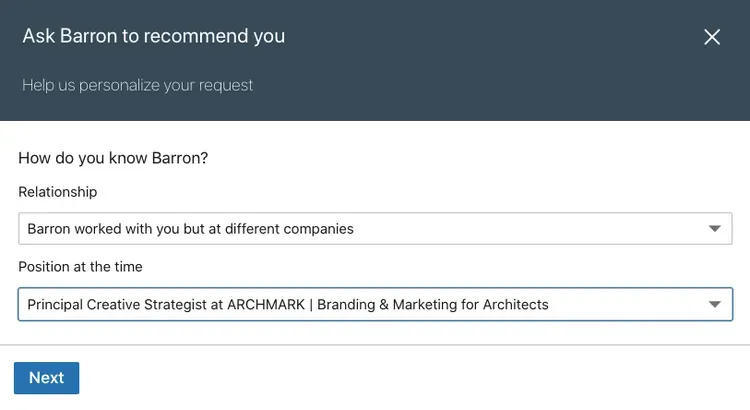
Requesting a Recommendation
It’s easy to ask for a recommendation from someone. Go to the Recommendations Section of your profile and click the link “Ask for a recommendation” in the top right.
Then fill out the details and you are off to the races.
But before you start requesting those recommendations, here are a couple of helpful rules.
Rule Number One: Do not send a request unless you have asked the person first.
I find it very awkward when someone sends me one of these requests out of the blue.
My preference is to always message someone first and ask them if they are willing to provide me with a recommendation.
It’s just a courteous thing to do and people are more likely to do something they have already agreed to do.
Rule Number Two: Don’t limit recommendation requests to clients.
Whenever I speak at an event, appear on a podcast, provide someone with free coaching, whenever someone tells that they received value from me, I’m going to ask them for a recommendation.
Rule Number Three: Don’t use the standard message.
When you request a recommendation, you’ll first fill out the details of who you want to request the recommendation from, your relationship with them, and the position you are requesting the recommendation for.
Next, you’ll be taken to a screen where you will see the following message:
“Hi [First Name], could you write me a recommendation?”
IMPORTANT — Do not hit SEND at this point. Do not use this message, it’s nothing more than a placeholder.
Unfortunately, most people use this placeholder message. You do not want to do what most people do, do you?
If you are going to request a recommendation from someone, take the time to send a personalized note with your request.
Remind the person about your conversation when they agreed to give you the recommendation.
Tell them how grateful and honored you are. Butter them up with praise.
Make them feel good about recommending you.
It also helps to give them a head start, and there are two ways to do this:
- Write the recommendation for them, and ask them to edit it and approve it.
- Send them guidelines for a well-written recommendation
The first option is best when you know the person very well or they said something to you directly that you specifically want them to say in their recommendation.
Often, if you write the recommendation, they will be grateful that you did it because you are taking the pressure off of them.
However, when you don’t know them, I like to send them a recommended outline for a well-structured recommendation, so I usually send something like:
Hi [First Name],
Thank you again for your nice comments about...
And thank you for your willingness to write a recommendation for me.
Here is a simple framework that you may find useful in writing your recommendation.
Step 1: Begin with a “Standout Line” that sums up your impressions of my work.
Step 2: Give context by explaining how you know me.
Step 3: Share characteristics or factors that stood out to you.
Step 4: Include some details about the value you received.
Step 5: Summarize everything with your recommendation.
If you have any questions, please let me know.
Thank you and best regards,
Bryon
I find that when I send a template like this, the reviews are well-written and very helpful.
LinkedIn allows you to request edits to recommendations before publishing them, but I find that this approach works well and reduces the need for me to request any changes other than grammar or spelling errors.
11. The Accomplishments Section
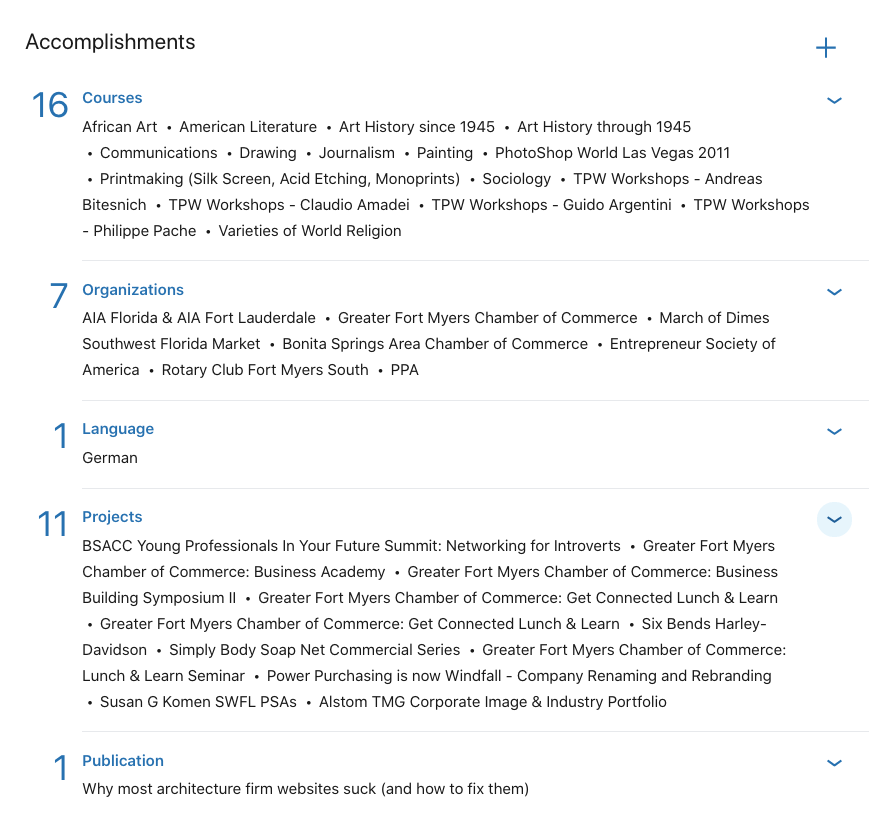
The items in this section are what I refer to as ‘nice to haves.’ This section does not carry the weight that some of the others do, because the items are grouped into one block titled ‘Accomplishments’ - and it appears towards the bottom of your profile. Each sub-section can be expanded to reveal more details, but most people agree that this section does not get as much attention as some of the other, more prominent sections.
For this reason, how much time and effort you spend on this section is up to you.
Keep in mind that LinkedIn does change things from time to time, so, at some point in the future, these entries may become more prominent.
Here’s a brief rundown of each subsection of the Accomplishments section:
Publications
This is a dedicated space on your profile for sharing publications you’ve been featured in. You can provide a brief description, date, and publication name, as well as a link to the article or publication.
Patents
Here you can share any patents that you’ve been granted, including the relevant details and a link to the patent.
Courses
You can use this area to add a list of coursework to provide more details about your education.
Projects
Similar to the Featured section, here you can highlight significant projects you've completed.
In most cases, I would put your prominent projects in your Featured section, because they will get more notice there, but this section allows you to share additional projects as well.
Also remember that it is possible to add media to your Work Experience entries, and this would be another more prominent place to add information about your top projects.
To some degree, this section seems undermined by the Featured and Work Experience sections, so you’ll have to judge for yourself if you want to information in this section of your profile.
Honors & Awards
If you’ve won significant honors awards, this is a good place to list them.
However, we highly recommend that you be sure to include a description for each award to explain its significance and relevance to your connections.
Listing awards for the sake of listing awards seems to be a common practice on architecture firm websites. But just because you are proud of winning the Best Facade award from your local AIA chapter, it doesn’t mean it will be relevant to your ideal clients.
Use your best judgment.
Test Scores
I think this section would be more relevant to other industries.
However, if you got a perfect score on a test and you think it’s relevant to your audience, feel free to post it here.
Languages
If you speak more than one language, this is where you can include that information.
Organizations
This is where you can share any relevant organizations that you belong to.
These can include the AIA, Rotary, Chambers of Commerce, and other organizations that you are involved in.
Again, relevant is the keyword here.
However, similar to the Projects section, I feel that many of the items you would list here could probably be listed under the Volunteer Experience section.
12. The Interests Section
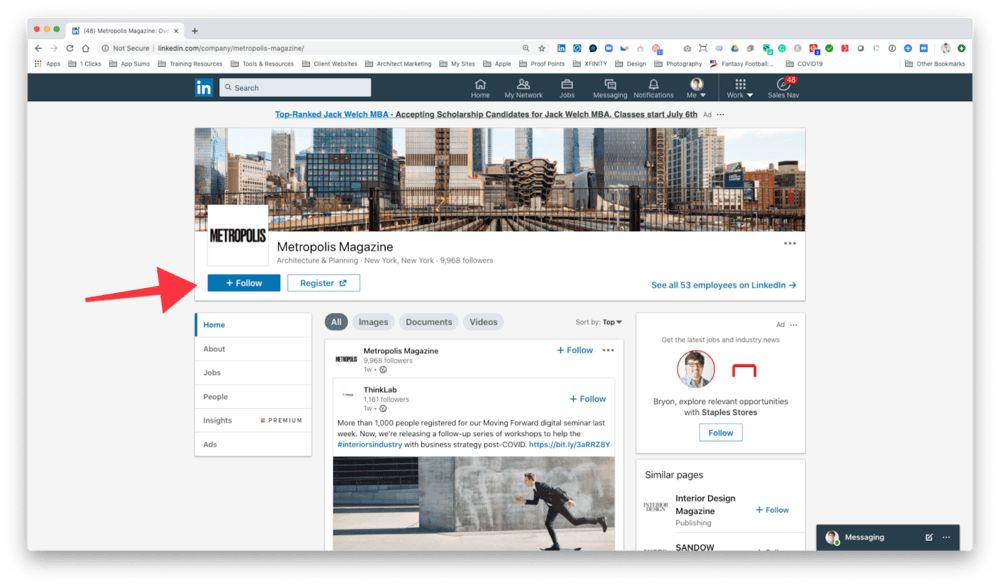
Unlike the sections we’ve covered so far, Interests is a little different because, in this section, LinkedIn displays the news sources, influencers, companies, groups, and schools that you are following.
The interest section helps others understand which topics you’re curious about. It’s another way for them to see what you may have in common with them.
It’s easy to add interests to your profile. When you’re visiting a personal or company profile, click on the “+ Follow” button on their profile.
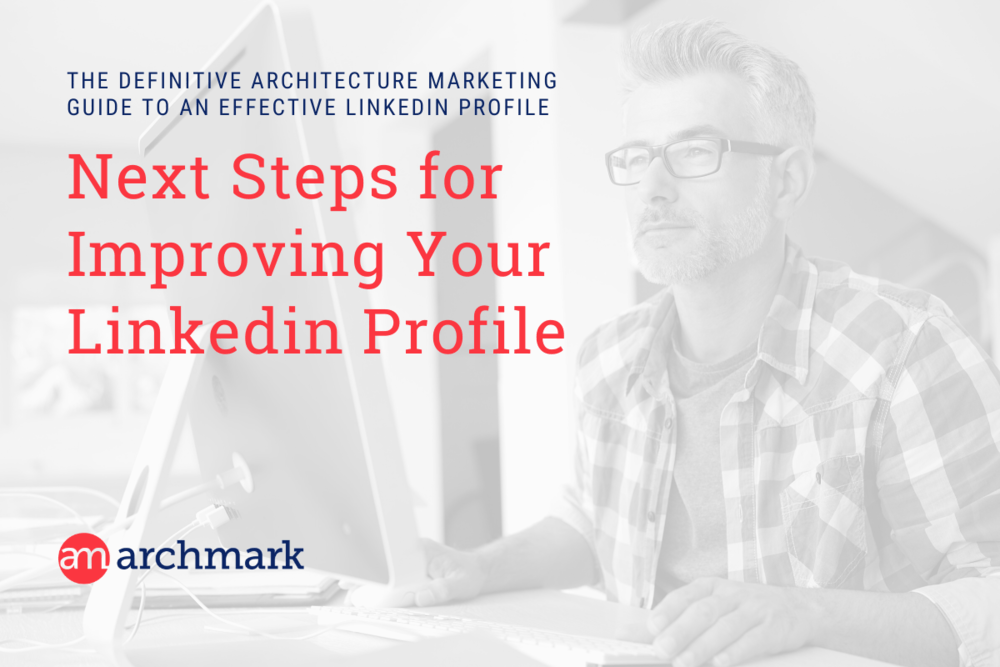
Next Steps for Improving Your LinkedIn Profile
Option Number One: Do It Yourself - DIY One Step at a Time
Updating your profile does not need to happen in one sitting. In fact, I am updating my profile all the time. It’s a work in progress.
What I recommend is that you start with your Intro and About sections. I honestly believe that investing most of your time into keeping these two sections current and up-to-date will provide you the best overall results.
Beyond that, my next recommendation would be to add some visual interest to your profile in the Featured Section.
Next, be sure to update at least your Work Experience, and, if you can, the other subsections in the Background Section.
If you spend half an hour a day, 2-3 days a week, completing your profile, within a couple of weeks, you should be able to make significant progress.
Once you are happy that your profile is up-to-date and current, I then recommend that you look through your profile from time to time, at least once every 3 or 6 months, and make small additions or updates as you see fit.
Don’t stress over it. Your profile will be there when you are ready to work on it.
To help you get started, download our LinkedIn Profile checklist. It’s a handy reference guide that summarizes the recommendations in this article, and it’s FREE.
Get started with our LinkedIn Profile Checklist
Jumpstart your LinkedIn makeover with some quick tips to improve your LinkedIn Profile. We've summed up the main steps of this article into a thorough but easy-to-follow 10-Point LinkedIn Profile Checklist. Click the blue button below to download your free checklist and get started making key updates to optimize your LinkedIn Profile.
Option Number Two: Hire Archmark
If you don’t have the time to update your profile, or if you want to do it quickly and professionally, you can hire a professional.
Our team at Archmark offers LinkedIn Profile Makeovers that will help you stand out and attract the right people—your ideal prospects, partners, and promoters.
Our process is straightforward and easy to follow. We’ll ask you to provide us with any source materials you may have, and then we’ll get on a Zoom call with you to ask you some key questions to help us identify and target your ideal audiences.
We’ll even create custom-designed, branded graphics for your Cover Image, Featured Section, and Media links in your Work Experience section.
We’ll take your profile from bland to grand in no time.
If you are interested in refreshing your LinkedIn Profile and learning more about how you can use content marketing, let’s talk!
14. Take Charge: Don’t Neglect Your LinkedIn Profile
Whether you Do-It-Yourself or hire us, don’t neglect your LinkedIn Profile, it is a highly visible part of your online presence.
Take time to improve your profile and make a great first impression.
And once you do, say goodbye to Passive Business Development.
Avoid those bad fit clients.
Take charge of your appearance online, so you can:
- Choose who you attract.
- Increase your visibility in the markets you serve
- Become the ‘go-to’ architect
- Create a consistent new client attraction system
Once you do, then it will be time to start sharing inspiring content, chatting to potential clients, and mastering the art of virtual networking, on LinkedIn.
But we’ll save that for a future article.


